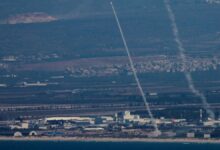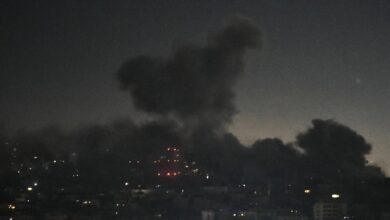Israel Launches Airstrikes Around Gaza’s Second Largest City, Escalating Conflict

- According to Israeli military evacuation maps, the population has been ordered out of 62 square kilometers (24 square miles) in and near Khan Younis since the truce collapsed.
- The UN reported that more than 50,000 northern refugees live in 21 shelters in that area, which had 117,000 residents before the war.
Israel intensified its bombardment in and around Gaza’s second largest city early Tuesday as ambulances and private cars raced to a local hospital with wounded in a bloody new phase of the war.
Israel says it is being more precise as it expands its offensive into southern Gaza after destroying much of the north under US pressure to prevent mass casualties. Three-fourths of the territory’s 2.3 million people have fled due to aerial bombardment and ground offensives.
Ambulances brought dozens of wounded to Khan Younis’ Nasser Hospital overnight. A car pulled up and a man emerged with a bloody shirt’d boy whose hand was blown off.
“Where is the Red Cross?… where is the UN?” a woman shouted outside the ER. “My children are still under the rubble since 10 p.m.”
Sunday satellite photos showed tanks and troops massing outside Khan Younis, the offensive’s latest target and home to over 400,000 people before the war.
Israel ordered people out of nearly two dozen neighborhoods instead of the entire region as in the north. Most of Gaza’s population is already in U.N. shelters and family homes in the south, leaving few options. People who fled the north earlier in the war cannot return to Israel.
Israeli strikes across the besieged territory make Palestinians feel unsafe, and many fear they will never be allowed to return home.
THE QUEST TO ELIMINATE HAMAS
Israel says it must dismantle Hamas’ extensive military infrastructure and remove it from power to prevent a repeat of the Oct. 7 attack that started the war. Hamas and other Palestinian militants killed 1,200 civilians and captured 240 men, women, and children in the surprise border fence attack.
The Israeli military claims it spares civilians and accuses Hamas of using them as human shields in dense residential areas where it has tunnels, bunkers, rocket launchers, and sniper nests.
But the militant group is deeply rooted in Palestinian society, and most Palestinians support its goal of ending decades of Israeli military rule, even those who oppose its ideology and attacks on Israeli civilians. That will make eliminating Hamas without mass casualties and displacement difficult.
Last week, Hamas leaders in Gaza managed to negotiate a complex cease-fire and release more than 100 Israeli and foreign hostages in exchange for 240 Palestinian prisoners after weeks of bombardment. Palestinian militants fired rockets into Israel before and after the truce.
Fighting has devastated the coast with unprecedented death and destruction.
The Gaza Health Ministry reported 15,890 deaths, 70% of them women and children, and over 42,000 injuries since Oct. 7. The ministry does not distinguish civilian and combatant deaths. It claims hundreds have died or been wounded since the cease-fire, and many are still under rubble.
After weeks of doubting the ministry’s Gaza death toll, an Israeli army official gave a similar figure on Monday. The official said at least 15,000 people, including 5,000 militants, were killed without explaining how the military calculated its figures. Military says 84 soldiers died in Gaza offensive.
On Monday, White House national security adviser Jake Sullivan said it was too early to judge Israeli operations, but that it was unusual for a modern military to identify precise ground maneuver areas and ask people to leave, as Israel did in Khan Younis.
He said, “These are the kinds of steps we have asked them to undertake.” “We have these conversations every day.”
Since the Oct. 7 attack, the US has provided Israel with weapons and other aid.
The ground offensive and airstrikes in northern Gaza have left large parts of Gaza City and nearby areas in ruins. Hundreds of thousands fled south during the attack.
Most of Gaza’s 2 million residents live in 230 square kilometers (90 square miles) of southern and central Gaza. According to Israeli military evacuation maps, the population has been ordered out of 62 square kilometers (24 square miles) in and near Khan Younis since the truce collapsed.
This cuts Palestinian space by over a quarter.
KHAN YOUNIS IN THE CROSSHAIRS
The Associated Press analyzed Sunday satellite photos early Tuesday to find 150 Israeli tanks, armored personnel carriers, and other vehicles just under 6 kilometers (3.7 miles) north of Khan Younis. The army rarely discusses troop deployments and did not respond.
Khan Younis was illuminated Monday night by constant bombardment.
Over the past few days, Israeli strikes have been “on a ferocious scale,” said Khan Younis Medical Aid for Palestinians aid worker Mohammed Aghaalkurdi.
He said people fled neighborhoods and shelters. Israeli military leaflets advise Gazans to head south toward Egypt, but Israel and Egypt refuse to accept refugees.
PalTel reported another Gaza phone and internet outage Monday evening, adding to the chaos. Another outage complicated rescue efforts. Communication resumed hours later.
About a fifth of Khan Younis was evacuated by Israel. The UN reported that more than 50,000 northern refugees live in 21 shelters in that area, which had 117,000 residents before the war. It was unknown how many fled.
Israeli media reported intense fighting between Israeli troops and Hamas militants in northern Gaza, including in the built-up Jabaliya refugee camp and Shijaiya, which have seen intense bombardment and battles in recent weeks.







Facebook Comments